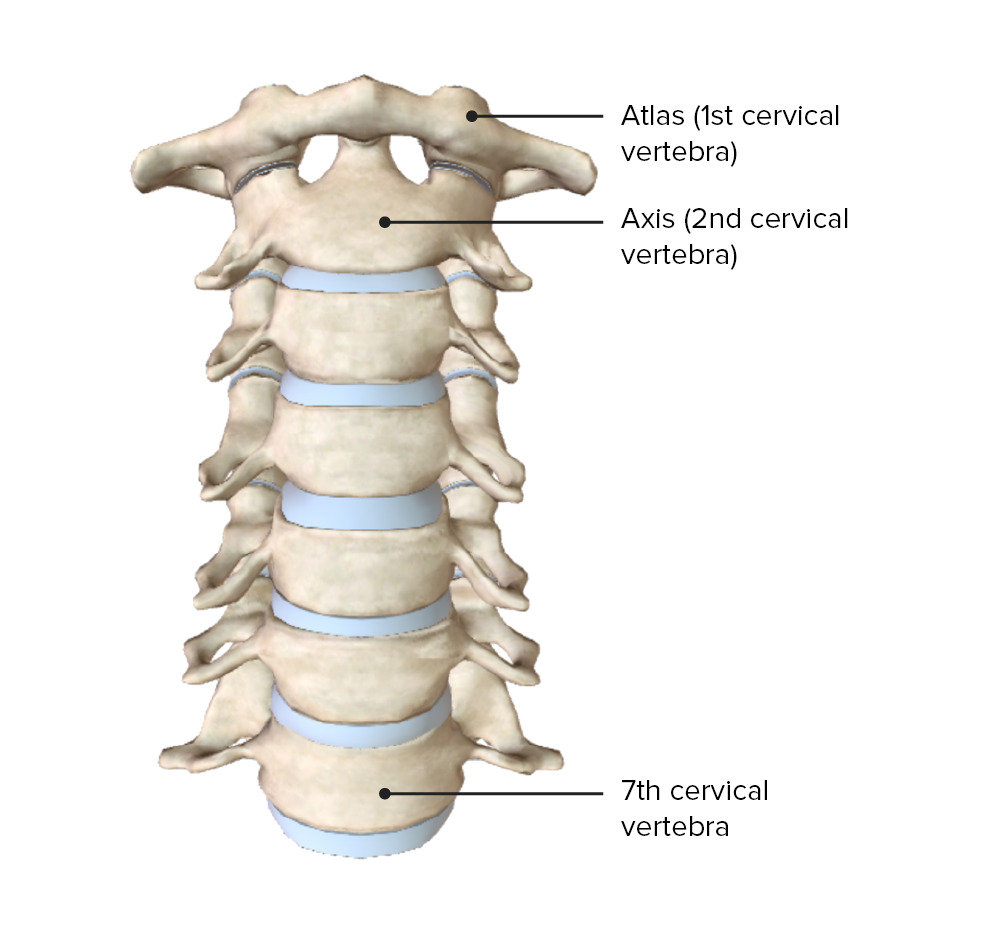Playlist
Show Playlist
Hide Playlist
Ligaments – Vertebral Column
-
Slides 02 Abdominal Wall Canby.pdf
-
Download Lecture Overview
00:01 Some ligaments that are associated with the vertebral column. There are several, some more important than others and what we want to take home from this particular lecture, but you as a learner, should understand quite importantly are anterior and posterior longitudinal ligaments. 00:23 Here we’re looking at an anterior view and we see the anterior longitudinal ligament. 00:31 It’s going to run from the sacrum all the way up to the occiput or the occipital bone of the skull. It will connect to the vertebral bodies and the intervening intervertebral discs. Because the surface area anteriorly is pretty large, the width of the anterior longitudinal ligament is also going to be wide. 01:04 The anterior longitudinal ligament will help stabilize the vertebral column during extension. 01:12 So, if we flex, move forward and then extend, it will help to stabilize the vertebral column in that extension. The more we extend, the tighter it becomes. 01:34 Located posteriorly and attached to the posterior aspects of the vertebral bodies as well as the posterior aspects of the intervertebral discs is our posterior longitudinal ligament. 01:48 And we see a deeper portion of the posterior longitudinal ligament here and then we see a more superficial component of our posterior longitudinal ligament. And in through here, it’s attached to the posterior aspects of the vertebral bodies. And note that we have the pedicles on either side. So, consequently, because the pedicles are limiting structures, the posterior longitudinal ligament is much narrower as a band than would be the anterior longitudinal ligament. 02:23 And then when you get at the level of the intervertebral discs, you no longer have that limitation. So, there are lateral extensions of the posterior longitudinal ligament on either side of the central bands. The posterior longitudinal ligament does just the opposite functionally of the anterior longitudinal ligament and that will be to stabilize the vertebral column during flexion. Also, if you have a herniation of an intervertebral disc, note that this is a weaker area here laterally from the central band. So, a herniation of the intervertebral disc is going to come out posterolateral to your posterior longitudinal ligament on either side. 03:13 Another type of ligament that’s associated with the vertebral column is the ligamentum flavum. Flavum means yellow. And these are yellow, elastic ligaments that run from lamina to lamina. And so, this area here is the ligamentum flavum on this side. And here is the ligamentum flavum on the opposite side, again, running from lamina to lamina. And we see more of these ligaments as we move inferiorly in this particular illustration. 03:52 Right down here is the posterior midline. So, projecting into the screen away from you as a viewer of this lecture would be the spinous process of this vertebra. And then the spinous process of the vertebra below. And if you look in the posterior midline, you can see that there is generally a very slight gap between the ligamenta flava as they do not fuse in the posterior midline. 04:22 Because of their elastic nature, ligamenta flava will help to limit or check separation of the vertebral column during flexion. So, as you flex, you put greater tension on the elastic ligaments and the more tension you place on them, the more that will help to limit or restrict that range of movement. 04:49 Interspinous ligaments orbit around between the spinous processes. So, we see them here and here, spinous processes and then we have an inner spinous process here. These are poorly developed in the cervical area. And we can also see in this particular view, a nice intervertebral disc. This is the nucleus pulposus region that was discussed a moment ago. And then here’s an end plate here above and an end plate here below. And so, this shows those structural features more clearly. Interspinous ligaments will help to limit or check the separation of spinous processes during flexion. 05:48 We also have supraspinous ligaments and these will run from the tips of spinous processes to the next ones below or above depending on where you start. Supraspinous ligaments will run from the vertebra prominens, again known as C7, and will extend inferiorly to the level of the sacrum. These two will help to limit separation of spinous processes during flexion. 06:25 The ligamentum nuchae runs from the occiput down to C7. So, it’s this midline ligamentous structure. This specific attachment point to the skull is known as the external occipital protuberance. And the inferior limit of our ligamentum nuchae will be at the spine of C7, the vertebra prominens. So, the reality here is the ligamentum nuchae represents the superior expansion of the supraspinous ligament within this particular anatomic region. It will become taut during flexion and as result of that, it helps to limit that movement. 07:16 Now that brings us to our summary. So, what are the take-home messages from this particular lecture on the vertebral column? First, the vertebral column is made up of five segments - cervical, thoracic, lumbar, sacral and coccygeal. And typically, we will have 33 vertebrae that make up the entire vertebral column. 07:44 The vertebral column is made up of primary and secondary curvatures. Primary curvatures form during development and increase the volume in the thoracic area and pelvic area to house important organs within those two anatomic regions. 08:07 Secondary curvatures in the cervical area and in the lumbar area represent developmental milestones. Secondary curvatures will develop in the cervical area when the infant is learning to hold up his head and neck. And then in the lumbar area, the secondary curvature will develop when the infant is learning to walk and become more mobile. 08:36 The two basic components of a typical vertebra would be the body and the vertebral arch. 08:45 Segmental specification is demonstrated by structurally modifying the vertebral components. 08:53 And then lastly, vertebral articulations and attendant ligaments will confer and either limit or increase the freedom of range of movement. 09:06 Thank you for joining me on this lecture on the “Vertebral Column”.
About the Lecture
The lecture Ligaments – Vertebral Column by Craig Canby, PhD is from the course Abdominal Wall with Dr. Canby.
Included Quiz Questions
What vertebral ligament may allow herniation of an intervertebral disc due to its narrow width?
- Posterior longitudinal ligament
- Anterior longitudinal ligament
- Ligamentum flavum
- Interspinous ligament
- Ligamentum nuchae
Which of the following describes the attachment points of the posterior longitudinal ligament?
- C2 to sacrum
- C1 to sacrum
- C3 to sacrum
- Occiput to sacrum
- Occiput to coccyx
What are the attachments of the supraspinous ligaments?
- C7 to sacrum
- C6 to sacrum
- C2–C6
- C3 to lumbar vertebrae
- C4–L2
Which ligament stabilizes the body during extension?
- Anterior longitudinal ligament
- Posterior longitudinal ligament
- Ligamentum flavum
- Interspinous ligaments
- Ligamentum nuchae
What vertebral segment allows the greatest range of motion due to its orientation of the zygapophyseal joints?
- Cervical segment
- Thoracic segment
- Lumbar segment
- Sacral segment
Customer reviews
5,0 of 5 stars
| 5 Stars |
|
1 |
| 4 Stars |
|
0 |
| 3 Stars |
|
0 |
| 2 Stars |
|
0 |
| 1 Star |
|
0 |
Thank you for your wonderful lectures, very easy to remember the topic after listening you




